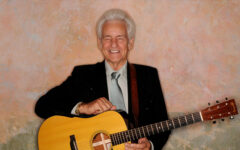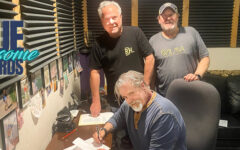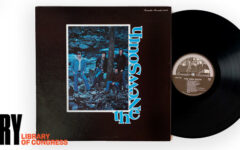
This response to our article last week, Who’s the real Father of Bluegrass, is a contribution from Richard D. Smith, a mandolin player based in Somerset County, NJ, and the author of Bluegrass: An Informal Guide and Can’t You Hear Me Callin’: The Life of Bill Monroe, Father of Bluegrass. He has been a regular contributor to Bluegrass Unlimited and other magazines.
December 8th stands out in bluegrass history as the date of two landmark events: the 1962 concert by Lester Flatt, Earl Scruggs & the Foggy Mountain Boys in New York City’s prestigious Carnegie Hall, and, especially, the 1945 Grand Ole Opry debut of Scruggs as a member of Bill Monroe & His Blue Grass Boys.
The recent 75th anniversary of that Opry performance has renewed calls for Earl Scruggs and not Bill Monroe to be considered the true “Father of Bluegrass.” Proponents argue that bluegrass music — as it’s now loved and performed across America and around the world — only flared into existence when Scruggs added the spark of his syncopated 3-finger banjo picking to Monroe’s fiery style of string band music.
That viewpoint was thoughtfully expressed on Bluegrass Today (December 3rd) in David Morris’s appreciative appreciative opinion piece, Who’s the Real Father of Bluegrass?
It’s a vitally important question that I had to address in my book, Can’t You Hear Me Callin’: The Life of Bill Monroe, Father of Bluegrass. But I didn’t agree then with the Scruggs-centric view of the true birth of bluegrass. And, with all respect, I still don’t agree with it.
There’s no denying that the Blue Grass Boys band circa 1945 to 1948 was very special. Not only was Bill’s mandolin and vocal genius superbly supported by future musical partners Lester and Earl; Chubby Wise’s soulful fiddling also came to influential prominence in that lineup, a bluegrass supergroup if ever there was one. But I believe this band – and Earl Scruggs’ role in it – is really a direct continuation of Monroe’s creative work since the 1938 breakup of the Monroe Brothers, his popular duo with singer/guitarist Charlie.
Ralph Rinzler, the folklorist, musician and festival producer who helped revive Monroe’s career in the 1960s, became keenly aware of this cumulative creative process right from his first serious conversations with Bill. As Ralph recounted in Jim Rooneys book, Bossmen: Bill Monroe & Muddy Waters:
‘The one thing he was extremely aware of was that he had fashioned his music. His music didn’t happen and it wasn’t intuitive. He consciously did it. The way a painter takes his brush and dips his brush into different colors on that palette, he can tell you exactly where he gets every sound in his music.”
Earl Scruggs’ amazing mastery and advancement of syncopated banjo picking provided a veritable rainbow of musical colors for Monroe. But Bill had hired other banjo players in the years before he met Earl. (He’d even offered the banjo slot to the great Don Reno, who had to decline due to military service obligations.) Dave “Stringbean” Akeman was the Blue Grass Boys’ five-string man when he gave notice in late 1945. Wanting to retain the banjo sound, Bill specifically asked his then-fiddler Jimmy Shumate, “Do you know anyone?”
Shumate surely did: Earl Scruggs, a 21-year-old former farm boy from North Carolina. Earl had come to Nashville with a group that had failed to get on the Opry and was disbanding. “He don’t play like String,” Shumate reported, “but he picks a whole lot of banjo.” Bill asked Jimmy to set up an audition with Earl. The rest is history.
Earl Scruggs didn’t introduce Bill Monroe to the banjo. And most of the characteristic elements of bluegrass pre-date Earl’s hiring, notably its “high lonesome” vocals, tight harmonies and – especially – its distinctive beat: a surging, anticipating rhythm that brought great energy to even stately or bluesy slow songs.
Indeed, I’ll go a bit further. It’s likely that Scruggs’ revolutionary banjo picking caused such a sensation on the night of December 8, 1945, not just through Earl’s awesome talents but also because his picking was now both firmly anchored and immensely elevated by Monroe’s timing in ways it hadn’t been before.
As great and genre-defining as Earl Scruggs was, he can’t be considered the “father” of bluegrass. His banjo playing was absolutely brilliant, yes. But it was one of several vital elements used in the construction of bluegrass by its master builder, Bill Monroe.
To put it another way: Scruggs-style banjo didn’t come early enough to be the cornerstone of bluegrass. But it was the crucial keystone in its magnificent arch as a distinctive new American music form.







